
MARS OPPORTUNITY ROVER
LANDS IN LIFE: Part-1 of 4
Report #141
June 15, 2008
PART-2 ..... PART-3 ..... PART-4
Most of you didn't know that I and this work had been invited to appear at the Society for Scientific Exploration's (SSE) annual meeting to present some of this work's evidence near the end of June and they were footing the bill for it. I had accepted and most definitely wanted to appear before this group of learned PhD's and scientists out on their own lonely cutting edges of science. Why? Because of my respect for their straight forward curosity and making such an offer favorable to this work by simply treating it objectively.
Treating this work objectively is really all that it takes to get me interested but I still had to back out with an early notice to them nearly two months ago. The reason is in part because the preparation for this meeting required too much of my now very limited time and in part because I am very slow in what I do. Obviously, both factors gobble up a lot of time.
Also, primarily it would have interfered with the coming soon release of my book and its strong water and biological life evidence and I can't let anything interfere with that. Likewise, leaving my little safer sphere of influence to go out in the world across state lines where I may be more vunerable may have been a bit risky prior to the release of the book as it might tempt my adversaries a little too much, that is if they thought some action against me might stop the book's evidence release. Once the book evidence is released, my risk factor goes down some simply because what's the point for them after that?
However, I haven't forgotten about the SSE open honest offer and still appreciate the demonstrated objectivity, so this report is dedicated to them whether any of them agree with the report's content or not. This evidence is some that I have been holding back ever since the Opportunity Rover landed on Mars years ago. I did so thinking that I might include it in the book but presenting it requires too much dedicated imaging for that on just one evidence of life and so this is a good place for it. Some of the evidence is interpretive when considered isolated and lone but I think I have enough collective visual evidence tied together to make a good case for what will be revealed here in this reporting. So now let's get on with it.
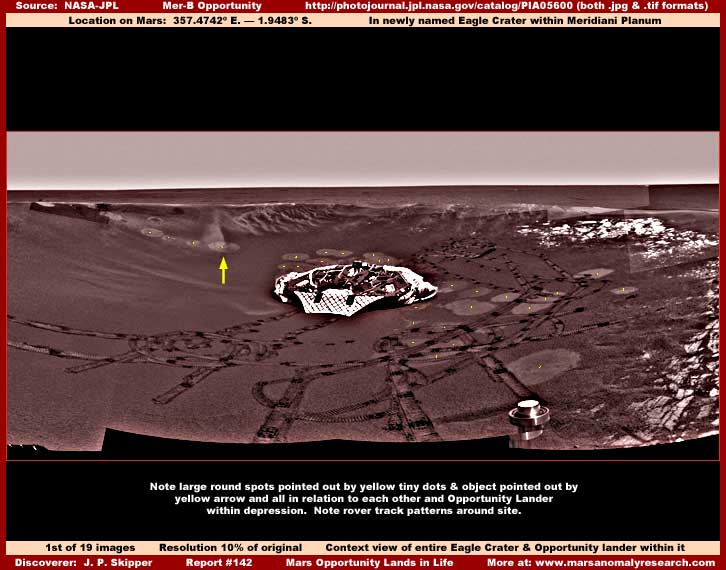
The above 1st wide-angle image demonstrates the Opportunity rover context mosaic image view of its newly landed lander located down in a shallow depression in the Mars Meridiani plain that has been named Eagle Crater. Note the shape of the depression with its defined rocky rim and apparent open empty terrain beyond the rim. Note the location of the lander within the depression and that it is essentially intact with its cushioning airbags crumpled up under it.
Now also note the rover track evidence as the rover moved around inside the depression in this pulverized fair loose grainulated soil before climbing to the rim and taking this image. Please also note the round more light reflective patches that are identified by tiny yellow dots as well as the location of the more unique patch location pointed out by the yellow arrow. These more light reflective patches are part of the anomalous evidence that will be reported on here. Note that the lander literally landed right on top of some of them.
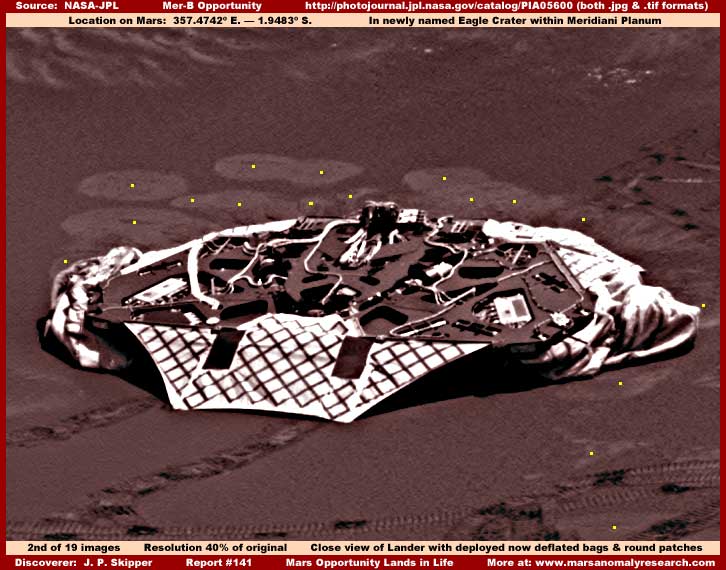
The above 2nd image demonstrates a closer view of the lander in Eagle Crater. Note the cushion air bags crumpled up under the edge of the lander. Note the position of the patches relative to the lander body. I point this out because I don't want you to later get confused that perhaps the light reflective patches are connected in some way to the lander cushions and/or their synthetic material.
Note here that some of the light reflective patches can again be seen and that the lander has clearly landed right on top of some. Note that the soil around the lander is pulverized and heavily granulated. The courseness of that granulated soil creates tiny shadows under and next to each granulated surface particle giving the soil a porous appearance and that in turn renders it less light reflective. On the other hand, the round light reflective patches are more light reflective because each demonstrates a much smoother continuous surface to the sunlight as compared to the adjacent soil. These factors are significant to understanding as you will learn.
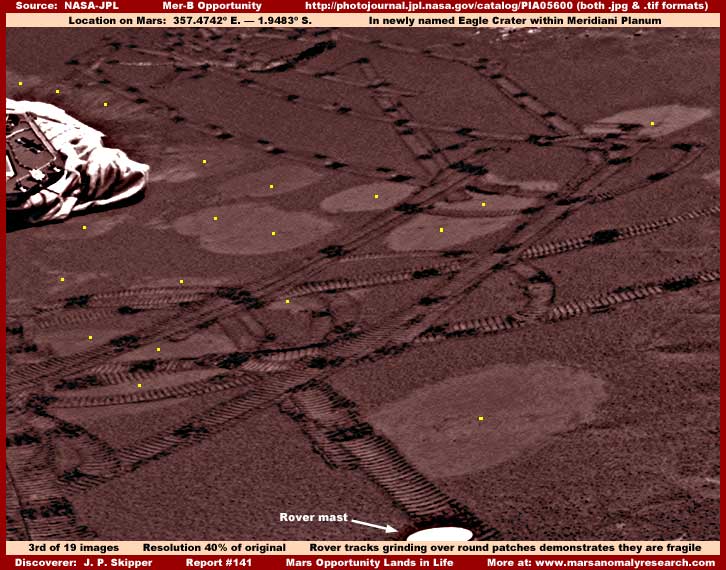
The above 3rd image demonstrates a view of the terrain to our right of the lander. Note the rover tracks around in this area and the heavy and very uniform granulated nature of the soil. Note that the tracks cross over and across a number of the light color patches. Note that the patches offer no resistance to the tracks and readily grind up and/or compress into the soil. This demonstrates just how thin and tender the patches are. Note the different sizes of the patches.
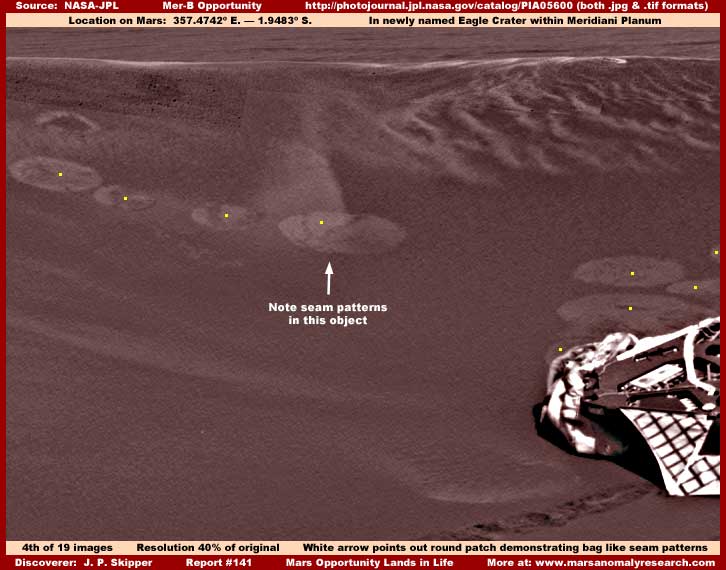
The above 4th image demonstrates a view of the terrain to our left of the lander. Again note the very granulated and very uniform nature of the soil. Note the patches and especially the one patch pointed out by white arrow and labeling. Note that this patch, although a little distantly seen, appears to have some well defined seams within its boundaries.
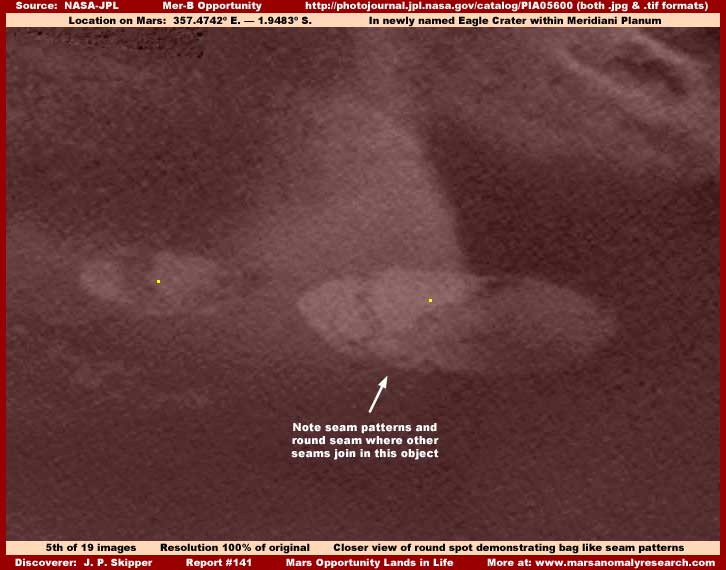
Now this imaging is a mosaic (made up of a number of raw images spliced together) panorama shot prepared by JPL and so moving closer on objects runs into resolution problems where things get more fuzzy. Even so, in the above 5th image you see a closer view of the patch pointed out by the white arrow in the 4th image. Here it again has a white arrow and labeling. Despite the poorer resolution, you can clearly see that this rounded patch on the near side demonstrates a round joined end seam and that longer straighter seams perpendicular to the round end join with it.
Also, I'd like to point out to you that this particular more light reflective patch exists nearly dead center on a small ridge of soil. Note the more light reflective soil on the left side of the ridge and the darker slightly shadowed right side. Note that the patch clearly conforms to this ridge of soil surface angles with the left half of the patch more light reflective matching the soil increased light reflectivity there on that side as compared to the right half.
I'm going to get right to it and postulate here that all of the rounded patches in this depression represent the remnant of life and have nothing to do with the lander and that the lander landed among this as preexisting evidence. Of course, just as soon as I do that and now that we have confirmed here the the cushion air bags are still under the lander, the counter will almost certainly be that the patches likely represent, if not themselves Lander bags, then the compression bounce and/or rolling around of the lander within its cushion air bags and the Lander air bags created these "impressions" on the ground.
The evidence in the above five images admittedly doesn't resolve these points, mine or theirs, by any stretch. However, now that the general stage and basic evidence scene is set here, let's move on to Part-2 and see if more evidence will better handle these issues.
Move on to:... PART-2
DOCUMENTATION
http://photojournal.jpl.nasa.gov/catalog/PIA05600: This link takes you to the official PIA05600 science data wide-angle mosaic image that is the source of all of my above five report images. Note that there is a 5.139 MB .jpg image and a 42.42 MB .tif image available here. For verification purposes, the .jpg image should do just fine.
![]()